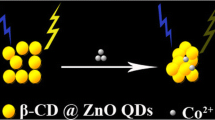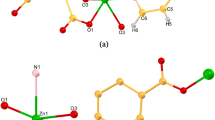Abstract
A two-dimensional zinc(II)-based metal-organic framework [Zn • (BA) • (BBI)] was synthesized from 1,2-benzenediacetic acid and 1,1′-(1,4-butanediyl) bis(imidazole) via a solvothermal reaction. The crystal exhibits good chemical stability in the pH range from 2 to 12, and strong fluorescence with excitation/emission maxima of 270/290 nm. The crystal is shown to by a viable fluorescent probe for the detection of ascorbic acid (AA) and the antibiotics chloramphenicol (CHL) and ceftriaxone (CRO). Fluorescence intensity of crystal dispersion is significantly quenched with increasing concentrations of AA/CHL/CRO. Quenching occurs even in the presence of other substances. The assay is fast (5 s) and has a low detection limit (1.6 ppb for AA, 12 ppb for CHL and 3.9 ppb for CRO). The crystal still has a good quenching effect on AA/CHL/CRO after washing and using for five times. The response of the probe is related to the interplay between the MOF and analytes via energy absorption competition.

Schematic diagram of preparing Zn • (BA) • (BBI) and responding to target analytes. BA: 1,2-phenyldiacetic acid; BBI: 1,1′-(1,4-butanediyl)bis(imidazole); Zn • (BA) • (BBI): Crystal chemical formula.









Similar content being viewed by others
References
Sheng ZH, Zheng XQ, Xu JY, Bao WJ, Wang FB, Xia XH (2012) Electrochemical sensor based on nitrogen doped graphene: simultaneous determination of ascorbic acid, dopamine and uric acid. Biosens Bioelectron 34(1):125–131. https://doi.org/10.1016/j.bios.2012.01.030
Wang B, Lv XL, Feng D, Xie LH, Zhang J, Li M, Xie Y, Li JR, Zhou HC (2016) Highly stable Zr(IV)-based metal-organic frameworks for the detection and removal of antibiotics and organic explosives in water. J Am Chem Soc 138(19):6204–6216. https://doi.org/10.1021/jacs.6b01663
Qin X, Wang Q, Geng L, Shu X, Wang Y (2019) A "signal-on" photoelectrochemical aptasensor based on graphene quantum dots-sensitized TiO2 nanotube arrays for sensitive detection of chloramphenicol. Talanta 197:28–35. https://doi.org/10.1016/j.talanta.2018.12.103
Zhao D, Yu G, Tian K, Xu C (2016) A highly sensitive and stable electrochemical sensor for simultaneous detection towards ascorbic acid, dopamine, and uric acid based on the hierarchical nanoporous PtTi alloy. Biosens Bioelectron 82:119–126. https://doi.org/10.1016/j.bios.2016.03.074
Silva FO (2005) Total ascorbic acid determination in fresh squeezed orange juice by gas chromatography. Food Control 16(1):55–58. https://doi.org/10.1016/j.foodcont.2003.11.007
Na W, Li N, Xingguang S (2018) Enzymatic growth of single-layer MnO2 nanosheets in situ: application to detect alkaline phosphatase and ascorbic acid in the presence of sulfanilic acid functionalized graphene quantum dots. Sensors Actuators B Chem 274:172–179. https://doi.org/10.1016/j.snb.2018.07.116
Hu L, Zhang Q, Gan X, Lin S, Han S, Zhang Z (2018) Fluorometric turn-on determination of the activity of alkaline phosphatase by using WS2 quantum dots and enzymatic cleavage of ascorbic acid 2-phosphate. Microchim Acta 185(8):390. https://doi.org/10.1007/s00604-018-2929-9
Diuzheva A, Balogh J, Studenyak Y, Cziaky Z, Jeko J (2019) A salting-out assisted liquid-liquid microextraction procedure for determination of cysteine followed by spectrophotometric detection. Talanta 194:446–451. https://doi.org/10.1016/j.talanta.2018.10.026
Chen F, Wang YM, Guo W, Yin XB (2019) Color-tunable lanthanide metal-organic framework gels. Chem Sci 10(6):1644–1650. https://doi.org/10.1039/c8sc04732d
Qin Z-S, Dong W-W, Zhao J, Wu Y-P, Zhang Q, Li D-S (2018) A water-stable Tb(iii)-based metal–organic gel (MOG) for detection of antibiotics and explosives. Inorganic Chemistry Frontiers 5(1):120–126. https://doi.org/10.1039/c7qi00495h
Zhang L, Qin J, Yang Q, Wei S, Yang R (2019) Redox modulated fluorometric sensing of ascorbic acid by using a hybrid material composed of carbon dots and CoOOH nanosheets. Microchim Acta 186(6):368. https://doi.org/10.1007/s00604-019-3483-9
Wang Y, Yang Y, Liu W, Ding F, Zou P, Wang X, Zhao Q, Rao H (2019) A carbon dot-based ratiometric fluorometric and colorimetric method for determination of ascorbic acid and of the activity of ascorbic acid oxidase. Microchim Acta 186(4):246. https://doi.org/10.1007/s00604-019-3341-9
Hu Z, Deibert BJ, Li J (2014) Luminescent metal-organic frameworks for chemical sensing and explosive detection. Chem Soc Rev 43(16):5815–5840. https://doi.org/10.1002/chin.201443273
Anik U, Timur S, Dursun Z (2019) Metal organic frameworks in electrochemical and optical sensing platforms: a review. Mikrochim Acta 186(3):196. https://doi.org/10.1007/s00604-019-3321-0
Nagarkar SS, Desai AV, Ghosh SK (2014) A fluorescent metal-organic framework for highly selective detection of nitro explosives in the aqueous phase. Chem Commun (Camb) 50(64):8915–8918. https://doi.org/10.1039/c4cc03053b
Xu H, Gao J, Qian X, Wang J, He H, Cui Y, Yang Y, Wang Z, Qian G (2016) Metal–organic framework nanosheets for fast-response and highly sensitive luminescent sensing of Fe3+. J Mater Chem A 4(28):10900–10905. https://doi.org/10.1039/c6ta03065c
Ma Y, Su H, Kuang X, Li X, Zhang T, Tang B (2014) Heterogeneous nano metal-organic framework fluorescence probe for highly selective and sensitive detection of hydrogen sulfide in living cells. Anal Chem 86(22):11459–11463. https://doi.org/10.1021/ac503622n
Tian D, Liu XJ, Feng R, Xu JL, Xu J, Chen RY, Huang L, Bu XH (2018) Microporous luminescent metal-organic framework for a sensitive and selective fluorescence sensing of toxic Mycotoxin in moldy sugarcane. ACS Appl Mater Interfaces 10(6):5618–5625. https://doi.org/10.1021/acsami.7b15764
Guo X-Y, Zhao F, Liu J-J, Liu Z-L, Wang Y-Q (2017) An ultrastable zinc(ii)–organic framework as a recyclable multi-responsive luminescent sensor for Cr(iii), Cr(vi) and 4-nitrophenol in the aqueous phase with high selectivity and sensitivity. J Mater Chem A 5(37):20035–20043. https://doi.org/10.1039/c7ta05896a
Zou J-Y, Li L, You S-Y, Cui H-M, Liu Y-W, Chen K-H, Chen Y-H, Cui J-Z, Zhang S-W (2018) Sensitive luminescent probes of aniline, benzaldehyde and Cr(VI) based on a zinc(II) metal-organic framework and its lanthanide(III) post-functionalizations. Dyes Pigments 159:429–438. https://doi.org/10.1016/j.dyepig.2018.07.005
Dinda D, Gupta A, Shaw BK, Sadhu S, Saha SK (2014) Highly selective detection of trinitrophenol by luminescent functionalized reduced graphene oxide through FRET mechanism. ACS Appl Mater Interfaces 6(13):10722–10728. https://doi.org/10.1021/am5025676
Das P, Mandal SK (2018) A highly emissive fluorescent Zn-MOF: molecular decoding strategies for solvents and trace detection of dunnite in water. J Mater Chem A 6(43):21274–21279. https://doi.org/10.1039/c8ta08546c
Kang X-M, Fan X-Y, Hao P-Y, Wang W-M, Zhao B (2019) A stable zinc–organic framework with luminescence detection of acetylacetone in aqueous solution. Inorganic Chemistry Frontiers 6(1):271–277. https://doi.org/10.1039/c8qi01260a
Chen X, Jiang H, Hou B, Gong W, Liu Y, Cui Y (2017) Boosting chemical stability, catalytic activity, and Enantioselectivity of metal-organic frameworks for batch and flow reactions. J Am Chem Soc 139(38):13476–13482. https://doi.org/10.1021/jacs.7b06459
Hong F, Lin X, Wu Y, Dong Y, Cao Y, Hu F, Gan N (2019) Enzyme-free fluorometric assay for chloramphenicol based on double stirring bar-assisted dual signal amplification. Microchim Acta 186(3):150. https://doi.org/10.1007/s00604-018-3148-0
Zhu Y, Yan K, Xu Z, Wu J, Zhang J (2019) Cathodic "signal-on" photoelectrochemical aptasensor for chloramphenicol detection using hierarchical porous flower-like bi-BiOI@C composite. Biosens Bioelectron 131:79–87. https://doi.org/10.1016/j.bios.2019.02.008
Munawar A, Tahir MA, Shaheen A, Lieberzeit PA, Khan WS, Bajwa SZ (2018) Investigating nanohybrid material based on 3D CNTs@cu nanoparticle composite and imprinted polymer for highly selective detection of chloramphenicol. J Hazard Mater 342:96–106. https://doi.org/10.1016/j.jhazmat.2017.08.014
Chang CC, Wang G, Takarada T, Maeda M (2017) Iodine-mediated etching of triangular gold Nanoplates for colorimetric sensing of copper ion and Aptasensing of chloramphenicol. ACS Appl Mater Interfaces 9(39):34518–34525. https://doi.org/10.1021/acsami.7b13841
Chullasat K, Kanatharana P, Bunkoed O (2019) Nanocomposite optosensor of dual quantum dot fluorescence probes for simultaneous detection of cephalexin and ceftriaxone. Sensors Actuators B Chem 281:689–697. https://doi.org/10.1016/j.snb.2018.11.003
Majidi MR, Asadpour-Zeynali K, Hafezi B (2011) Electrocatalytic oxidation and determination of ceftriaxone sodium antibiotic in pharmaceutical samples on a copper hexacyanoferrate nanostructure. Anal Methods 3(3). https://doi.org/10.1039/c0ay00582g
Zhao W, Zhang Y, Li Q (2008) Indirect spectrophotometric determination of sodium ceftriaxone with n-propyl alcohol-ammonium sulfate-water system by extraction flotation of copper(II). Clin Chim Acta 391(1–2):80–84. https://doi.org/10.1016/j.cca.2008.02.010
Xing P, Wu D, Chen J, Song J, Mao C, Gao Y, Niu H (2019) A cd-MOF as a fluorescent probe for highly selective, sensitive and stable detection of antibiotics in water. Analyst 144(8):2656–2661. https://doi.org/10.1039/c8an02442a
Zu F, Yan F, Bai Z, Xu J, Wang Y, Huang Y, Zhou X (2017) The quenching of the fluorescence of carbon dots: a review on mechanisms and applications. Microchim Acta 184(7):1899–1914. https://doi.org/10.1007/s00604-017-2318-9
Acknowledgements
This work was supported by the National Natural Science Foundation of China (Grant No. 51771001, 21471001 and 21575001), independent research and development project of Anhui Province (201904a07020001).
Author information
Authors and Affiliations
Corresponding authors
Ethics declarations
Conflict of interest
There are no conflicts to declare.
Additional information
Publisher’s note
Springer Nature remains neutral with regard to jurisdictional claims in published maps and institutional affiliations.
Electronic supplementary material
ESM 1
(DOCX 10 mb)
Rights and permissions
About this article
Cite this article
Liu, W., Qu, X., Zhu, C. et al. A two-dimensional zinc(II)-based metal-organic framework for fluorometric determination of ascorbic acid, chloramphenicol and ceftriaxone. Microchim Acta 187, 136 (2020). https://doi.org/10.1007/s00604-019-3979-3
Received:
Accepted:
Published:
DOI: https://doi.org/10.1007/s00604-019-3979-3




